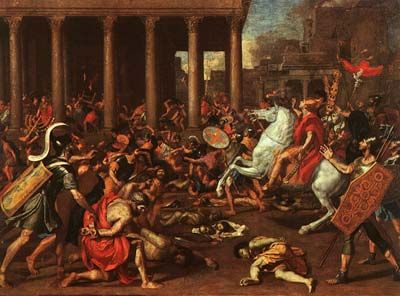Jesus spoke of a mysterious “abomination of desolation” as an end-time sign before His second coming. What is the “abomination of desolation” in the Bible?

Artist’s depiction of the desecration of the temple by Antiochus Epiphanes.
Who or what is the abomination of desolation?
The abomination of desolation is a prophetic event found in the book of Daniel (Daniel 12:11) and referred to by Jesus Christ (Matthew 24:15). Though it has historical fulfillments, there is also a future fulfillment when daily sacrifices will be offered in Jerusalem and then cut off and replaced by some sort of blasphemous display. This prophecy is significant because it represents an important time marker signaling the nearness of the return of Jesus Christ.
Jesus Christ referred to the “abomination of desolation” in His Olivet Discourse, mentioning it as an end-time sign before His return to the earth.
He said: “‘Therefore when you see the “abomination of desolation,” spoken of by Daniel the prophet, standing in the holy place’ …” (Matthew 24:15).
Jesus was referring to a prophecy originally given to the prophet Daniel: “And from the time that the daily sacrifice is taken away, and the abomination of desolation is set up, there shall be one thousand two hundred and ninety days” (Daniel 12:11).
What do “abomination” and “desolation” mean?
This phrase contains two important words: abomination and desolation. What are the meanings of these two words?
- Abomination.
In the Old Testament, the word translated “abomination” is shiqquwts. “The Hebrew root for abomination is shaqats, [which means] ‘to be filthy,’ ‘to loath,’ ‘to abhor’” (“Abomination of Desolation,” International Standard Bible Encyclopedia). It is most often used to describe idolatrous worship practices, especially those most offensive to a sense of decency and morality.
The New Testament equivalent is bdelygma, which means “a foul thing (loathsome on account of its stench), a detestable thing” (Thayer’s Greek Lexicon).
So an abomination is something that is abhorrent and detestable to God and His people.
- Desolation.
In the Old Testament, the word translated “desolation” (or “that which makes desolate”) is shamem, and means “to destroy, lay waste, devastate; to be astonished … something so horrible that it can leave a person speechless” (The Complete Word Study Old Testament, p. 2376).
In the New Testament the word is erēmōsis and essentially means the same thing, “a making desolate” (Thayer’s Greek Lexicon).
Thus, biblically, desolation involves destroying and desecrating and leaving something in such a horrible condition that an onlooker is left speechless.
So when we put these words together, we learn that Daniel and Jesus were describing a foul and abhorrent thing that will horribly desecrate and devastate an area within the city of Jerusalem.
Jesus described this thing as “standing in the holy place.” So this refers to a detestable thing that will be erected, or established, at the holy place (the place where priestly sacrifices were, and will be, carried out).
But what does the abomination of desolation refer to?
When we study this topic, we learn that this phrase doesn’t refer to one singular event. It refers to multiple events. Biblical prophecies sometimes have more than one fulfillment: a partial fulfillment and a final fulfillment. This is sometimes called prophetic duality.
The abomination of desolation actually has three fulfillments—two in the past and one in the future.
First fulfillment of the abomination of desolation
The prophet Daniel prophesied of an “abomination of desolation” (Daniel 11:31) within a long, detailed prophecy about the Greek kings who ruled over portions of the Greco-Macedonian empire after the death of Alexander the Great.
The kings of the North it focuses on (from Daniel 11:4-35) are known in history as rulers over the Seleucid Empire. They are named after one of Alexander’s generals, Seleucus I Nicator (approximately 358 to 281 B.C.), who emerged as one of the strongest generals after Alexander’s death. He ruled over a large swath of Alexander’s old empire that included the city of Babylon, Mesopotamia and central Asia (land generally to the north of Jerusalem).
Daniel’s prophecy described it this way: “Forces shall be mustered by him [Antiochus Epiphanes], and they shall defile the sanctuary fortress; then they shall take away the daily sacrifices, and place there the abomination of desolation” (verse 31).
Antiochus Epiphanes was hostile to Jewish worship and attempted to Hellenize (or enforce the adoption of Greek culture and religion on) the Jews in Judea. He outlawed all forms of Jewish worship and placed a Hellenized high priest over the temple who was sympathetic to his rule. He eventually outlawed practices like circumcision, the biblical dietary laws and Sabbath observance.
While Antiochus was on a military campaign in Egypt in 168 B.C., a group of Jews revolted against the high priest that Antiochus had appointed and took control of Jerusalem. Antiochus returned to Jerusalem and violently put down the rebellion, killing thousands of Jews and selling others into slavery.
In 167 B.C. Antiochus erected a statue of the Greek god Zeus in the Jerusalem temple. He also ordered that swine, biblically unclean animals, be offered on the temple altar, desecrating the holy place (fulfilling Daniel’s prophecy). These acts were loathsome, abhorrent and detestable to the Jewish people and were the first fulfillment of the abomination of desolation.
The history of this tragic event in Jewish history, and the Maccabean revolt it inspired, are recorded in the noncanonical books of the Maccabees. These books give some useful history, though they aren’t considered part of the inspired Scripture.
Second fulfillment of the abomination of desolation
A second fulfillment of the abomination of desolation occurred in A.D. 70 when Roman armies under Titus sacked the city of Jerusalem. In the process, Titus’ forces destroyed the temple building and altar. It has not been rebuilt to this day. Luke 21:20 identifies Jerusalem being “surrounded by armies” before its desolation in A.D. 70.
This event also appears to be the forerunner of a similar event that will happen shortly before the return of Christ.
The future fulfillment of the abomination of desolation
When Jesus spoke about the “abomination of desolation,” He was speaking in the context of a discussion about the “end of the age” (Matthew 24:3, 13-14).
Jesus said, “‘Therefore when you see the “abomination of desolation,” spoken of by Daniel the prophet, standing in the holy place’ (whoever reads, let him understand), ‘then let those who are in Judea flee to the mountains’” (verses 15-16).
So here we see another fulfillment of the “abomination of desolation” to occur in the future.
We should also note that Daniel 12:11, which mentions this abomination of desolation being set up, also states that the daily sacrifices will be taken away. Since the Jews are not currently offering any daily sacrifices in Jerusalem, this means that daily sacrifices will be reestablished at some point in the future. For sacrifices to be offered, an altar must be constructed.
Students of Bible prophecy watch for the reestablishment of Jewish sacrifices in Jerusalem.
Students of Bible prophecy watch for the reestablishment of Jewish sacrifices in Jerusalem. To learn more about this, read our article “When Will a Third Temple Be Built?” and our blog post “Does Prophecy Require a Third Temple to Be Built?”
What this end-time fulfillment of this “abomination that makes desolate” will be is not yet clear. It will be something established in Jerusalem that is abhorrent to God. The apostle Paul wrote about a future leader called “the man of sin,” who “opposes and exalts himself above all that is called God or that is worshiped, so that he sits as God in the temple of God, showing himself that he is God” (2 Thessalonians 2:3-4).
The book of Revelation reveals a future political figure called the “beast” who will be allied with a religious figure known as the false prophet. Together, they will invade Jerusalem and control the city until Christ returns and overthrows them. It’s likely that this beast and false prophet will be responsible for setting up the future abomination of desolation. To learn more, read our article “The King of the North.”
What happens after the abomination of desolation?
After Jesus mentioned the end-time “abomination of desolation,” He warned that God’s people will have to flee (Matthew 24:16-20) because shortly after the “abomination of desolation” is set up, “there will be great tribulation” (verse 21). To learn more about this time, read “What Is the Great Tribulation?”
This is why the “abomination of desolation” is such an important prophetic marker for us to watch—because it signals that the Great Tribulation (an unprecedented 3½-year period of global war and suffering) is about to begin.
When the “abomination of desolation” is set up, faithful Christians who are watching and strong in God’s Spirit will understand what’s happened and will know the time has come to flee. Though the Bible says some of God’s people will be martyred, others will be protected (Revelation 12:11-17).
To learn more about that future protection, read “How Will Christians Be Protected From the Great Tribulation?”






